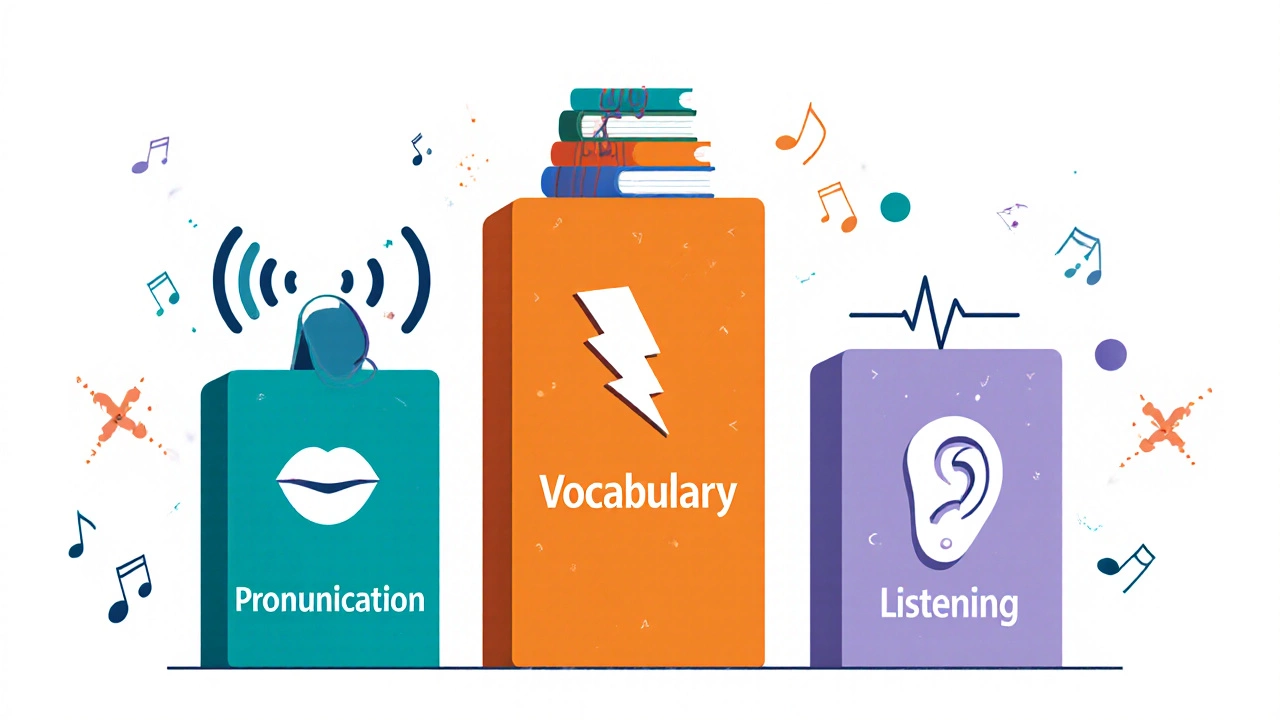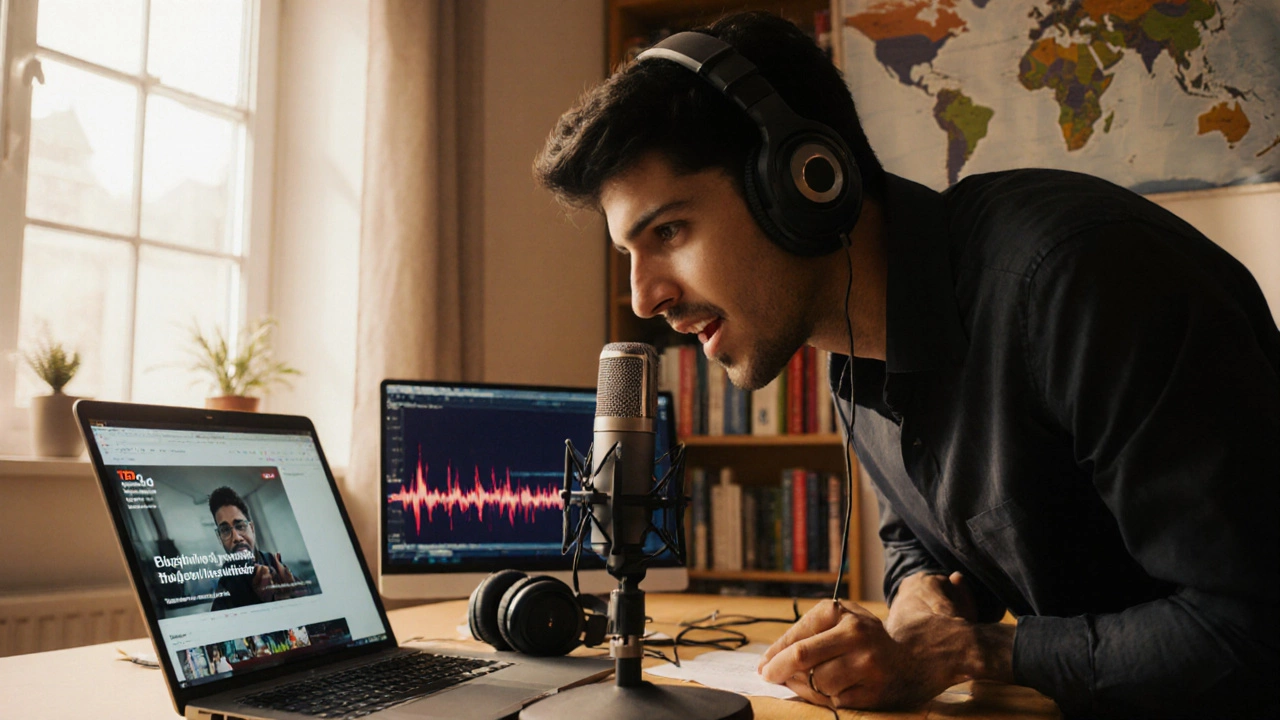Oct
10

- by Dhruv Ainsley
- 0 Comments
English Fluency Tracker
Your Fluency Journey
Track your progress across the three core pillars of fluent English speaking:
Pronunciation
20%
Vocabulary
30%
Listening
15%
Update Your Skills
Fluency Assessment
Based on your current skill levels, here's an assessment of your readiness:
Your overall fluency level is Beginner. Focus on pronunciation and listening skills to build a strong foundation.
Quick Takeaways
- Focus on three pillars: pronunciation, vocabulary, and listening.
- Use the 80/20 rule: 80% real‑world listening, 20% targeted drills.
- Practice aloud daily - short, intense sessions beat occasional marathons.
- Record yourself, compare with native models, and adjust instantly.
- Pick a tool that matches your schedule - tutor, app, or language exchange - and stick to it for at least 30days.
Want to sound natural when you speak English? The secret isn’t a magic app; it’s a systematic training plan that hits the right skills in the right order. Below you’ll find a step‑by‑step roadmap that turns casual learners into confident speakers.
fluent English speaking isn’t just about knowing words - it’s about weaving those words into smooth, intelligible speech. Let’s break down how to train that ability.
What “Fluent English Speaking” Really Means
Fluent English Speaking is the ability to understand spoken English instantly and respond with clear, natural‑sounding sentences without long pauses or heavy self‑correction. It involves three core components: pronunciation, vocabulary recall, and real‑time comprehension.
Fluency isn’t a static level; it’s a moving target that shifts as you encounter new topics. Think of it as a muscle - the more you stretch it in varied contexts, the more elastic it becomes.
Lay the Foundation: Pronunciation, Vocabulary, and Grammar
Pronunciation covers the sounds, stress patterns, and intonation that make speech sound native is the first barrier. Misplaced stress can turn “record” (noun) into “record” (verb) and confuse listeners. Use minimal pair drills - “ship vs. sheep”, “bat vs. bet” - and mimic the rhythm of a native speaker.
Vocabulary refers to the pool of words you can retrieve quickly in conversation grows faster when you learn words in context, not isolation. Read a short news article, highlight ten new terms, then create three sentences using each. The goal is active recall, not passive recognition.
Grammar provides the structural rules that bind words into meaningful sentences is essential, but don’t over‑engineer it. Focus on high‑frequency patterns - simple present, past simple, and modal verbs for advice. Master these and you’ll cover 80% of everyday dialogue.
Listening & Shadowing: The Real‑Time Loop
Listening comprehension is the skill of extracting meaning from continuous spoken English trains your brain to predict sounds and structures. Start with 2‑minute podcast clips (e.g., TED‑Ed). Listen once without subtitles, then replay with subtitles to spot gaps. Mark any words you missed and revisit them.
Shadowing takes listening a step further: repeat every phrase immediately after you hear it, matching speed, pitch, and pause. This builds muscle memory for pronunciation and rhythm. Aim for 5‑minute shadowing sessions daily - consistency beats length.

Practice Methods That Actually Push You to Speak
Passive study (reading or watching) solidifies input, but you need output to become fluent. Below are proven ways to force yourself to produce English.
- Language exchange partners a native speaker who wants to learn your language, creating a balanced conversation practice. Schedule 20‑minute video calls, start with small talk, then swap to a topic you’re learning.
- Speaking clubs are group meet‑ups (online or offline) where participants discuss prompts for a set time. The group dynamic reduces the fear of speaking alone.
- Hire an online tutor who provides real‑time correction, focused drills, and personalized feedback. Even a single 30‑minute session can pinpoint blind spots.
- Use speech‑recognition apps (e.g., Google Speech) to get instant feedback on intelligibility.
Pick at least two of these methods and rotate them weekly. Variety keeps motivation high and exposes you to different accents.
Immersion Hacks for a Busy Life
You don’t need to move to an English‑speaking country to immerse yourself. Small daily tweaks rack up exposure.
- Change phone, computer, and social‑media language settings to English.
- Label objects around your home with English words and a short phrase (e.g., "the fridge keeps food cold").
- Think in English for a few minutes before bed - narrate your day silently.
- Watch movies with English subtitles, then turn subtitles off for a second pass.
- Read aloud from a favorite novel, pausing to mimic character emotions.
These habits turn passive time (commuting, cooking) into active language practice.
Tracking Progress and Getting Feedback
Without measurement, you’ll never know if you’re improving. Set up a simple feedback loop:
- Record a 1‑minute monologue on a random topic every week.
- Compare the new recording with the one from the previous week using a rubric (pronunciation clarity, filler words, grammar accuracy).
- Ask a native speaker or tutor to note three specific areas to work on.
- Adjust your practice plan based on those notes.
Seeing concrete improvement fuels confidence and keeps you on track.
Choosing the Right Tool: Self‑Study vs. Tutor vs. App
| Method | Cost (per month) | Flexibility | Personal Feedback | Best For |
|---|---|---|---|---|
| Self‑Study (books, podcasts) | Free‑$20 | Very high - learn anytime | None unless you add a recording review | Budget‑conscious learners who love autonomy |
| Online Tutor (one‑on‑one) | $30‑$100 | Medium - scheduled sessions | Immediate, tailored correction | Those who need fast, targeted improvement |
| Language‑Learning App (Duolingo, Babbel) | $10‑$15 | High - app works on any device | Automated speech scoring, limited depth | Beginners who want structured lessons |
Pick the method that matches your timeline and budget, then layer a secondary tool for extra practice (e.g., self‑study + weekly tutor).
Common Pitfalls and How to Dodge Them
- Focusing only on grammar. Grammar without speaking feels like theory. Pair each rule with a spoken drill.
- Being afraid of mistakes. Mistakes are data points. Record them, analyze, and move on.
- Skipping regular speaking. Even 5 minutes a day beats a 2‑hour marathon once a week.
- Relying solely on subtitles. Subtitles can become a crutch; turn them off as soon as you feel comfortable.
Action Plan: 30‑Day Fluency Sprint
- Day 1‑5: Diagnose your weak spots. Record a 2‑minute self‑intro, get feedback from a friend.
- Day 6‑10: Daily 10‑minute pronunciation drills (minimal pairs) + 15‑minute listening (podcast snippet).
- Day 11‑15: Add a 20‑minute language‑exchange call twice a week.
- Day 16‑20: Incorporate shadowing of a 3‑minute TED talk daily.
- Day 21‑25: Book two 30‑minute tutoring sessions focusing on the feedback you collected.
- Day 26‑30: Record a 3‑minute talk on a new topic, compare with Day 1, note improvements.
Stick to the schedule, and you’ll notice smoother speech, fewer filler words, and higher confidence.
Next Steps & Troubleshooting
If you hit a wall, try these quick fixes:
- Plateau on pronunciation? Switch to a different accent model (British vs. American) for a week.
- Feeling shy on calls? Start with text‑based language exchange, then transition to voice.
- Time crunch? Use “micro‑practice”: repeat a phrase while waiting for coffee.
Remember, fluency is a marathon built from many short sprints. Adjust, keep moving, and the results will follow.
Frequently Asked Questions
How much time do I need each day to become fluent?
Consistency beats duration. Aim for 20‑30 minutes of focused speaking practice daily. Even short bursts improve muscle memory faster than irregular long sessions.
Is it better to learn British or American English?
Choose the accent that matches your goals (career, travel, media consumption). The key is consistency; switching between accents too often can confuse pronunciation patterns.
Can apps replace a live tutor?
Apps are great for structured drills, but they lack nuanced, real‑time correction. Pair an app with occasional live tutoring for best results.
How do I overcome the fear of making mistakes?
Treat mistakes as data. Record, identify the error, fix it, and move on. The more you speak, the quicker the nervousness fades.
Should I focus on vocabulary size or phrase chunks?
Phrase chunks ("what do you think about…") are more useful for fluency because they come ready‑made for conversation. Learn vocabulary within those chunks.





